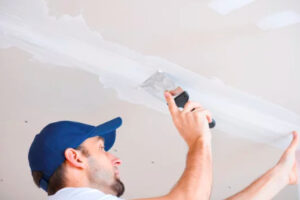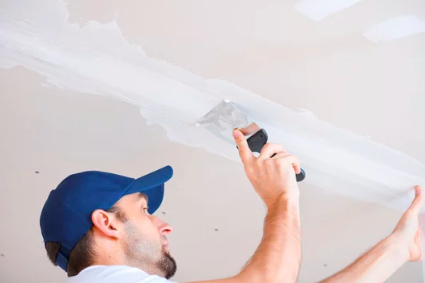Drywall Repair Las Vegas is a common home improvement project that can improve the appearance of your interior walls. It can also reduce the amount of money you spend on repairs. Small holes in drywall from doorknobs or other sources are minor blemishes that can be patched by a do-it-yourselfer with a putty knife and spackling paste.
Drywall repair can be expensive, especially when multiple areas need attention. However, it is also a necessary part of home maintenance that can help keep your house looking good and increase its value. Some repairs are minor and can be done by a handyperson, while others require the skills of a professional. Some of the factors that determine drywall repair cost are the type of damage, the size of the area, and the number of rooms affected.
Some drywall professionals charge by the hour, while others may work by the square foot. It is important to ask for free estimates from several professionals in your area. This will help you make a better decision on who to hire. Some drywall professionals may also provide additional services, such as painting and textured ceilings.
Small dents and holes caused by doorknobs or nail pops can be repaired with patch kits and spackle. This can save you money, but it is not recommended that homeowners try to do this work themselves. A pro can complete the task more quickly and accurately. They can also spot other issues, such as water damage, that need to be addressed immediately.
Cracks in drywall can be a sign of a structural problem, and should always be repaired by a professional. These problems can result from a variety of reasons, such as movement in the home’s foundation or moisture from leaky roofs or pipes. They can also occur due to settling of the framing lumber.
Large cracks in drywall are more difficult to fix than smaller cracks, and can require the replacement of whole sections of drywall. The cost of repairing these larger cracks can range from $100 to $400, depending on the extent of the damage and how it is fixed.
If you have a few cracks that need to be repaired, you can save money by scheduling them all at once. This will reduce the labor costs and prevent you from getting overwhelmed by the project. Another way to reduce costs is by shopping around for the best price on materials and labor.
Materials
The materials required for drywall repair depend on the type of damage. Small nail holes and other surface imperfections are usually easy to fix with spackle or joint compound, a small putty knife and a sanding block. Larger holes will likely require a patch kit that includes a piece of drywall, drywall tape and a plastic compound spreader to apply the mud. A hammer, screwdriver and sanding tool are also essential for any drywall repair project. Some drywall contractors invest in dustless sanding tools to reduce the amount of dust generated during the sanding process.
Drywall repair products are available at most lumber yards and home centers, as well as online. Depending on the size of your hole, you may choose to cover it with a self-adhesive fiberglass mesh patch or, if studs are visible, drive screws into it from above and below to strengthen it and reduce shifting. After installing the patch or tapping it into place, cover it with drywall tape to help hide the seam where the new and old drywall meet. Then, smooth and feather the edges to make the patch blend in with the wall.
If your drywall damage is extensive, you might need to replace the damaged section of wall. This can be costly, but if the wall is damaged by a leaky roof or a flood from an appliance such as a refrigerator or washing machine, it’s probably worth the investment to have a professional repair it.
Most drywall damage is cosmetic and won’t affect the structural integrity of your house. But a badly cracked or sagging wall can create a safety hazard and should be repaired as soon as possible. Likewise, holes in drywall can allow moisture to seep through into the wood framing and cause serious problems. Repairing drywall quickly can prevent mold, mildew and other problems. In addition, it’s important to maintain your drywall to keep it looking its best and protect the value of your home.
Time
Whether you are a do-it-yourselfer or hire a contractor, the amount of time needed for drywall repair depends on the size and scope of the project. Larger projects that require patching, taping and sanding can take several days. Small holes and cracks can be repaired much faster. It also takes less time to complete the job if it is done correctly the first time.
When choosing a contractor, ask about their training and experience. It is best to work with contractors who have a minimum of 10 years of experience in the trade. They should be able to demonstrate the skills and techniques necessary for a quality finished product. The contractor should also be able to show you examples of previous jobs. If you’re considering hiring a contractor, be sure to read reviews on consumer websites such as Angie’s List and HomeAdvisor. You can also find out if they have a license to perform drywall and painting.
Drywall is thin and susceptible to damage from many sources. It can be damaged by impact, such as from a doorknob or furniture, and also by moisture, which can cause deterioration and eventually lead to crumbling. Termite infestation can also destroy drywall.
In addition to the cost of materials, a professional drywall contractor will charge for labor and delivery fees. This can vary depending on geographic location and the local cost of living rates. In areas with high costs of living, a contractor will need to charge higher labor rates to compete with other companies.
A good drywall contractor will clean up their work area before leaving the job site. This ensures that no tools or debris remain on the floors of your home and also protects family members from health risks. Moreover, it also shows their professionalism and integrity.
To fix a hole in drywall, first cut out the old drywall with a utility knife or drywall saw. Then, apply a strip of self-adhering paper tape over the surface and smooth it with drywall compound (also known as mud). Lightly sand and prime the repaired area and paint. Be sure to remove any protruding pieces of paper from the edges of the hole. Voids like screw holes tend to suck in the mud and leave gaps that are difficult to cover with a subsequent coat of mud.
Experience
If you’re a do-it-yourselfer, drywall repair may not be as daunting as it seems. Small dents, nail holes, and chips can usually be fixed with spackle, a putty knife, sandpaper, and paint. The only reason you might call in a professional is for more serious issues, such as cracks and chips caused by furniture or other incidents, or water damage that causes the drywall to become brittle and crumble.
It’s important to choose a drywall contractor who is licensed and insured. Look for a company that offers free, no-commitment project estimates. This will help you compare the cost, timeframe, and other details of each contractor. You can also ask for a reference or visit their website to find out what others have said about them.
You can often spot a skilled drywall contractor by the way they finish their work. A seasoned technician will be able to smooth and sand the patch, caulk around any seams, and sand again to get the wall “paint-ready.” They’ll even do this without leaving any visible marks on your walls.
A poorly finished drywall job can leave behind blemishes that stand out against the rest of your home’s decor. It can also cause health problems if there is mold on the drywall, which can spread throughout the house and irritate allergies, making it hard for residents to breathe easily. If you suspect mold growth, it’s a good idea to call in a professional.
In addition to checking the company’s credentials and license, it’s a good idea to confirm that they’ll clean up their work area before they leave. This is a sign of professionalism and integrity, and it can also protect your family from any leftover dust or debris that could pose a safety hazard.
Drywall repair is a task that requires skill and experience, especially when it comes to larger projects. Larger projects or those involving structural or water damage should be left to professionals who are trained in drywall and painting. It’s also a good idea to check the company’s customer service policy and whether they accept various forms of payment. Many smaller companies don’t accept credit cards or checks because of the high processing fees, so it’s best to pay with cash.
